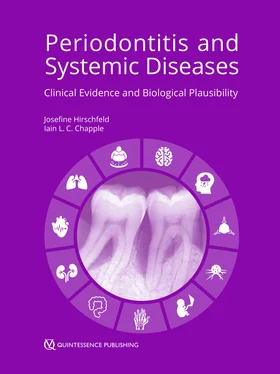SUMMARY
● A potential association between obesity and periodontitis was first reported in 1977.
● There are several confounding and risk factors related to obesity that should be adjusted for in future studies and biologically clarified to elucidate the association between obesity and periodontitis.
● Data from NHANES show that subjects older were 2.31 times more likely to have metabolic syndrome.
● 1% increment in waist-to-height ratio was associated with a 3% increase in the hazard of having periodontitis progression in a 2012 study.
● The overall level of evidence is low; therefore, an association cannot yet be confirmed.
1.2.2 Periodontitis and DM
Diabetes is one of the largest global health emergencies of the 21st century. In 2015, the International Diabetes Federation estimated that 415 million people worldwide have diabetes 43. Despite better awareness and new developments in the treatment of diabetes and prevention, an unrelenting increase has been observed in the number of people with the disease. By 2040, an increase to 642 million is expected, where a major concern is low- and middle-income countries and in those countries that have experienced rapid economic growth 44. The number could be higher, since there are numerous people from many countries that have the disease undiagnosed (especially in Africa, where it is estimated that more than 65% of individuals with diabetes remain undiagnosed) 45.
The percentage of adults with diabetes increased with age, reaching a high of 25.2% among those aged 65 years or older 46. The age-adjusted prevalence of diagnosed and undiagnosed diabetes is higher among Asians, non-Hispanic blacks, and Hispanics, respectively 46. According to the ADA, the estimated costs associated with diabetes in the United States in 2002 totalled US $132 billion, with direct medical costs of US $92 billion and indirect costs (disability, loss in work productivity and premature mortality) of US $40 billion 47. T1DM, previously referred to insulin-dependent diabetes or juvenile-onset diabetes, results from a cell-mediated autoimmune destruction of the insulin-producing pancreatic beta cells. It accounts for only 5% to 10% of those with diabetes 6and its prevalence increases at a rate of approximately 3% per year globally 43. It frequently occurs in childhood; however, 84% of people living with T1DM are adults. It affects both genders equally 46and decreases life expectancy by an estimated 13 years 48.
For over 70 years, researchers have been trying to understand the relationship between diabetes and periodontal diseases. The first study describing this relationship was published by Williams and Mahan 49, who found that patients with poorly controlled diabetes required less insulin after treatment of periodontal infection with extractions and antibiotics. Years later, Grossi and Genco 50postulated a ‘self-feeding two-way system of catabolic response resulting in more severe periodontitis and increased difficulty controlling blood sugar’.
1.2.2.1 Pathogenesis of DM
T1DM
T1DM is a disorder that arises following the autoimmune destruction of insulin-producing pancreatic beta cells, characterised histologically by insulitis (i.e., islet cell inflammation) and associated beta-cell damage. The disease is most often diagnosed in children and adolescents presenting with a classic trio of symptoms (polydipsia, polyphagia, polyuria) alongside hyperglycaemia 51. Many different theories have been postulated to explain its development, including molecular mimicry leading to the generation of an autoimmune response, alteration of self-antigens to a now antigenic self, defective major histocompatibility complex (MHC) expression on cells of the immune system, breakdown in central tolerance, deleterious trafficking of dendritic cells from beta cells to pancreatic lymph nodes, sensitivity of the beta cells to free radical or cytokine-induced damage local viral infection and defects in peripheral immune tolerance 52( Table 1-3).
T2DM
T2DM, previously referred to as non-insulin-dependent diabetes, or adult-onset diabetes, develops when beta cells fail to secrete sufficient insulin to keep up with the demand, usually in the context of increased insulin resistance 53. The development of T2DM is caused by a combination of lifestyle and genetic factors. Some of these factors can be controlled, such as diet and obesity, and other factors cannot, such as increasing age, female gender and genetics. Most patients with this form of diabetes are obese and weight loss improves insulin sensitivity in liver and skeletal muscle tissues. Genome-wide association studies have identified more than 130 genetic variants associated with T2DM, glucose levels or insulin levels; however, these variants explain less than 15% of disease heritability 54 , 55. The lifetime risk of developing T2DM is about 40% if one parent has T2DM and higher if the mother has the disease 56. In comparison, the risk for T1DM is about 5% if a parent has T1DM and higher if the father has the disease 57( Table 1-3).
Table 1-3 T1DM vs. T2DM
| T1DM |
T2DM |
| Autoimmune destruction of pancreatic beta cells |
Over time, insulin receptors become less sensitive/insulin resistance – beta cells deteriorate over time |
| Children/teenagers are mostly affected |
Adults, elderly and certain ethnic groups (African-American, Hispanic, Native American, Pacific Islander groups) are mostly affected |
| Lack of insulin |
Obesity as risk factor |
| About 5% of all diabetes cases |
About 95% of all diabetes cases |
| Involvement of kidneys, eyes and heart |
Involvement of kidneys, eyes and heart |
| Diet and exercise cannot reverse the condition |
Diet and exercise can reverse the condition |
| Extrinsic insulin requirement |
Oral medication, insulin may be required |
T1DM: type-1 diabetes mellitus; T2DM: type-2 diabetes mellitus
1.2.2.2 Interventional studies on the impact of glycaemic control upon complications of diabetes
Large clinical trials demonstrated the need of the glycaemic control to avoid systemic-related complications of diabetes. The Diabetes Control and Complications Trial (DCCT) and its follow-up study, the Epidemiology of Diabetes Interventions and Complications (EDIC) were conducted in 29 medical centres in the United States and Canada. They included 1441 volunteers aged 13 to 39 years with T1DM, monitored from 1982 to 1993 (DCCT) and from 1994 to 2014 (EDIC), with a mean follow-up period of 6.5 years, and assessed the incidence and predictors of cardiovascular disease events such as heart attack or stroke, as well as diabetes complications related to the eye, kidney and nervous system. In the DCCT study, the patients were randomised to either receive intensive therapy (at least three insulin injections per day or continuous subcutaneous insulin infusion with external pumps) in order to maintain safe asymptomatic glucose control (with a target of pre-meal glucose level between 70 and 120 md/dl and post-meal glucose levels less than 180 mg/dl) or conventional control (one to two insulin injections per day). The average blood glucose was 155 mg/dl in the intense control group and 231 mg/dl in the conventional group. It was observed that HbA1c in the intensively controlled group was 2% lower than in the control group, with a 76% reduction in retinopathy, 34% in the development of early nephropathy and 69% in the development of neuropathy 58. EDIC also observed that there was a reduction in cardiovascular events and death from cardiovascular disease when intense treatment in the previously conventionally controlled diabetes is provided 59.
In another large randomised controlled trial, The United Kingdom Prospective Diabetes Study (UKPDS), 5102 patients with newly diagnosed T2DM in 23 centres within the UK were studied between 1977 and 1991. Patients were followed for an average of 10 years. Intensive therapy (insulin or oral agents) was compared to conventional therapy (diet with or without pharmacological therapy). This study provided strong evidence that intense glycaemic control in T2DM (median HbA1c of 7.0% vs. 7.9%) can decrease the morbidity and mortality of the disease by decreasing its chronic complications. As observed in T1DM clinical trials, such as DCCT and EDIC, lowering blood glucose levels decreases retinopathy, nephropathy and possibly neuropathy, showing that hyperglycaemia is the cause of, or at least the major contributor to these complications. In addition, the epidemiological analysis of the UKPDS data showed that for every percentage point decrease in HbA1c, there was a 35% reduction in the risk of microvascular complications, 25% in diabetes-related deaths, a 7% reduction in all-cause mortality, and 18% in myocardial infarction. Importantly, there is no glycaemic threshold for these complications above normal glucose levels 60 , 61. Taken together, DCCT and UKPDS, along with other studies, demonstrate that glycaemic control is the key factor to control systemic complications related to DM.
Читать дальше











![John Bruce - The Lettsomian Lectures on Diseases and Disorders of the Heart and Arteries in Middle and Advanced Life [1900-1901]](/books/749387/john-bruce-the-lettsomian-lectures-on-diseases-and-disorders-of-the-heart-and-arteries-in-middle-and-advanced-life-1900-1901-thumb.webp)
